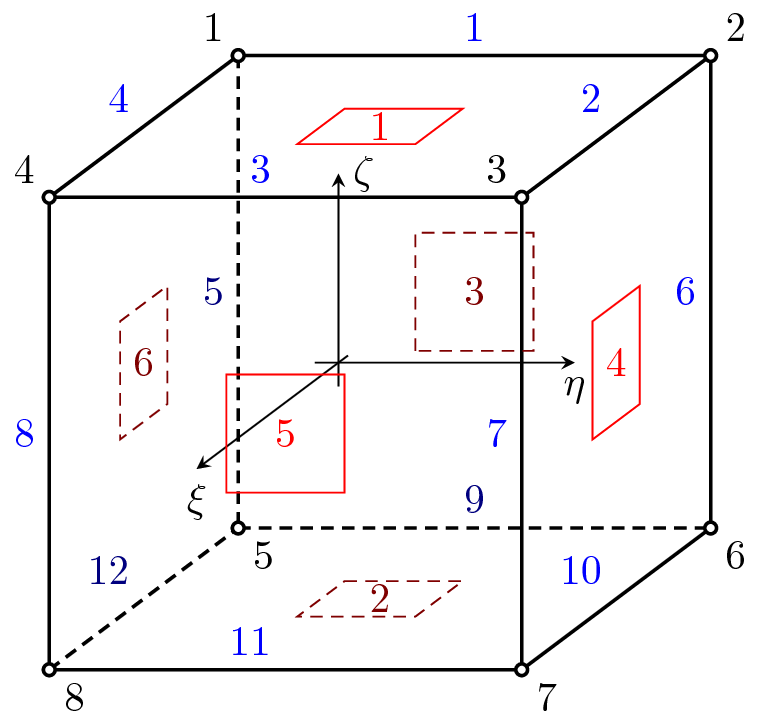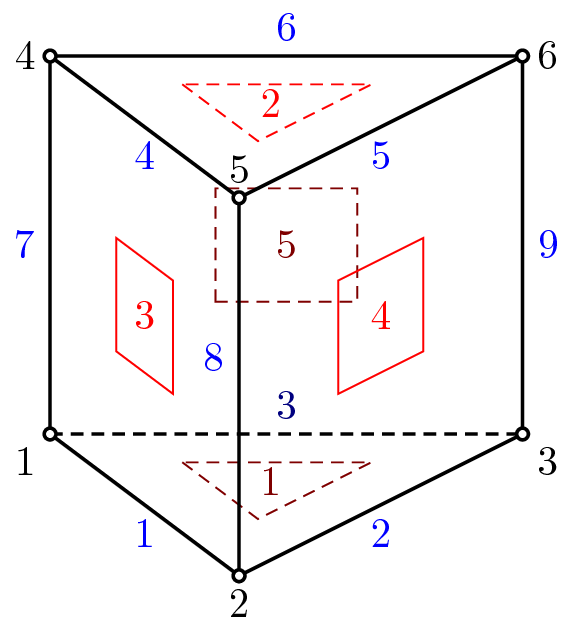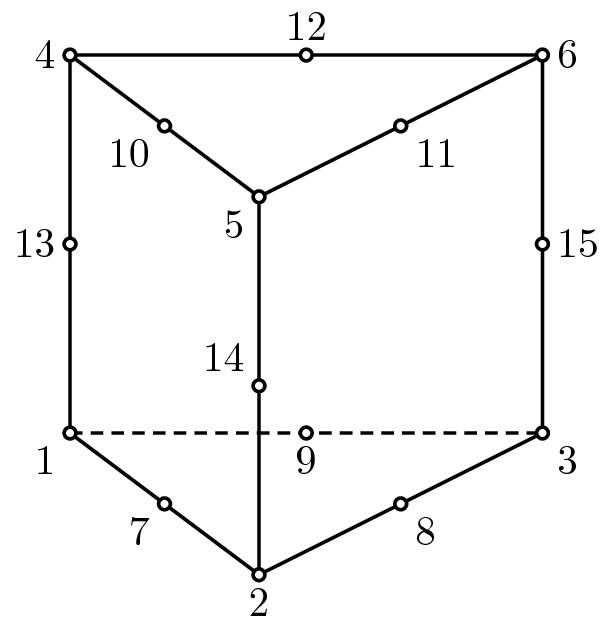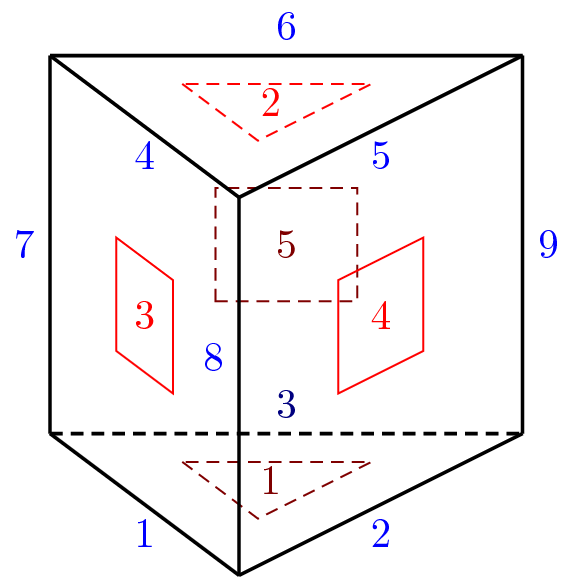
Implementation of Linear 3d eight - node finite element. Each node has 3 degrees of freedom. The element features are summarized in Table 33.

| Keyword | lspace |
| Description | Linear isoparametric brick element |
| Specific parameters | [NIP #(in)] |
| Parameters | NIP: allows to set the number of integration points (possible completions are 1, 8 (default), or 27). |
| Unknowns | Three dofs (u-displacement, v-displacement, w-displacement) are required in each node. |
| Approximation | Linear approximation of displacement and geometry. |
| Integration | Full integration of all strain components. |
| Features | Adaptivity support, Geometric nonlinearity support. |
| CS properties | - |
| Loads | - |
| Nlgeo | 0,1,2. |
| Status | Reliable |
Implementation of 3d brick eight - node linear approximation element with selective integration of deviatoric and volumetric strain contributions (B-bar formulation) for incompressible problems. Features and description identical to conventional lspace element, see section 2.8.1.
Implementation of quadratic 3d 20-node finite element. Each node has 3 degrees of freedom. The element features are summarized in Table 34.
| Keyword | qspace |
| Description | Quadratic isoparametric brick element |
| Specific parameters | [NIP #(in)] |
| Parameters | NIP: allows to set the number of integration points (possible completions are 1, 8 (default), or 27). |
| Unknowns | Three dofs (u-displacement, v-displacement, w-displacement) are required in each node. |
| Approximation | Quadratic approximation of displacement and geometry. |
| Integration | Full integration of all strain components. |
| Features | - |
| CS properties | - |
| Loads | - |
| Nlgeo | 0,1,2. |
| Status | Reliable |
Implementation of tetrahedra four-node finite element. Each node has 3 degrees of freedom. The element features are summarized in Table 35. Following node numbering convention is adopted (see also Fig. 14):
| Keyword | LTRSpace |
| Description | Linear tetrahedra element |
| Specific parameters | - |
| Unknowns | Three dofs (u-displacement, v-displacement, w-displacement) are required in each node. |
| Approximation | Linear approximation of displacements and geometry using linear volume coordinates. |
| Integration | Full integration of all strain components using four point Gauss integration formula. |
| Features | Adaptivity support, Geometric nonlinearity support. |
| CS properties | - |
| Loads | Surface and Edge loadings supported. |
| Nlgeo | 0,1,2. |
| Status | Reliable |
Implementation of tetrahedra ten-node finite element. Each node has 3 degrees of freedom. The element features are summarized in Table 36. Following node numbering convention is adopted (see also Fig. 15):
| Keyword | QTRSpace |
| Description | 3D tetrahedra element with quadratic interpolation |
| Specific parameters | [NIP #(in)] |
| Parameters | NIP: allows to alter the default integration formula (possible completions are 1, 4 (default), 5, 11, 15, 24, and 45 point intergartion formulas). |
| Unknowns | Three dofs (u-displacement, v-displacement, w-displacement) are required in each node. |
| Approximation | Quadratic approximation of displacements and geometry using linear volume coordinates. |
| Integration | Full integration of all strain components using four point Gauss integration formula. |
| Features | - |
| CS properties | - |
| Loads | - |
| Nlgeo | 0,1,2. |
| Status | Reliable |
Implementation of wedge six-node finite element. Each node has 3 degrees of freedom. The element features are summarized in Table 37. Following node numbering convention is adopted (see also Fig. 16):

| Keyword | LWedge |
| Description | 3D wedge six-node finite element with linear interpolation |
| Specific parameters | [NIP #(in)] |
| Parameters | NIP: allows to alter the default integration formula (possible completions are 2 (default) and 9 point integration formulas). |
| Unknowns | Three dofs (u-displacement, v-displacement, w-displacement) are required in each node. |
| Approximation | Linear approximation of displacements and geometry. |
| Integration | Full integration of all strain components using four point Gauss integration formula. |
| Features | - |
| CS properties | - |
| Loads | - |
| Nlgeo | 0,1,2. |
| Status | Reliable |
Implementation of wedge fifteen-node finite element. Each node has 3 degrees of freedom. The element features are summarized in Table 38. Following node numbering convention is adopted (see also Fig. 17):


| Keyword | QWedge |
| Description | 3D wedge six-node finite element with quadratic interpolation |
| Specific parameters | [NIP #(in)] |
| Parameters | NIP: allows to alter the default integration formula (possible completions are 2 (default) and 9 point integration formulas). |
| Unknowns | Three dofs (u-displacement, v-displacement, w-displacement) are required in each node. |
| Approximation | Quadratic approximation of displacements and geometry. |
| Integration | Full integration of all strain components using four point Gauss integration formula. |
| Features | - |
| CS properties | - |
| Loads | - |
| Nlgeo | 0,1,2. |
| Status | Reliable |